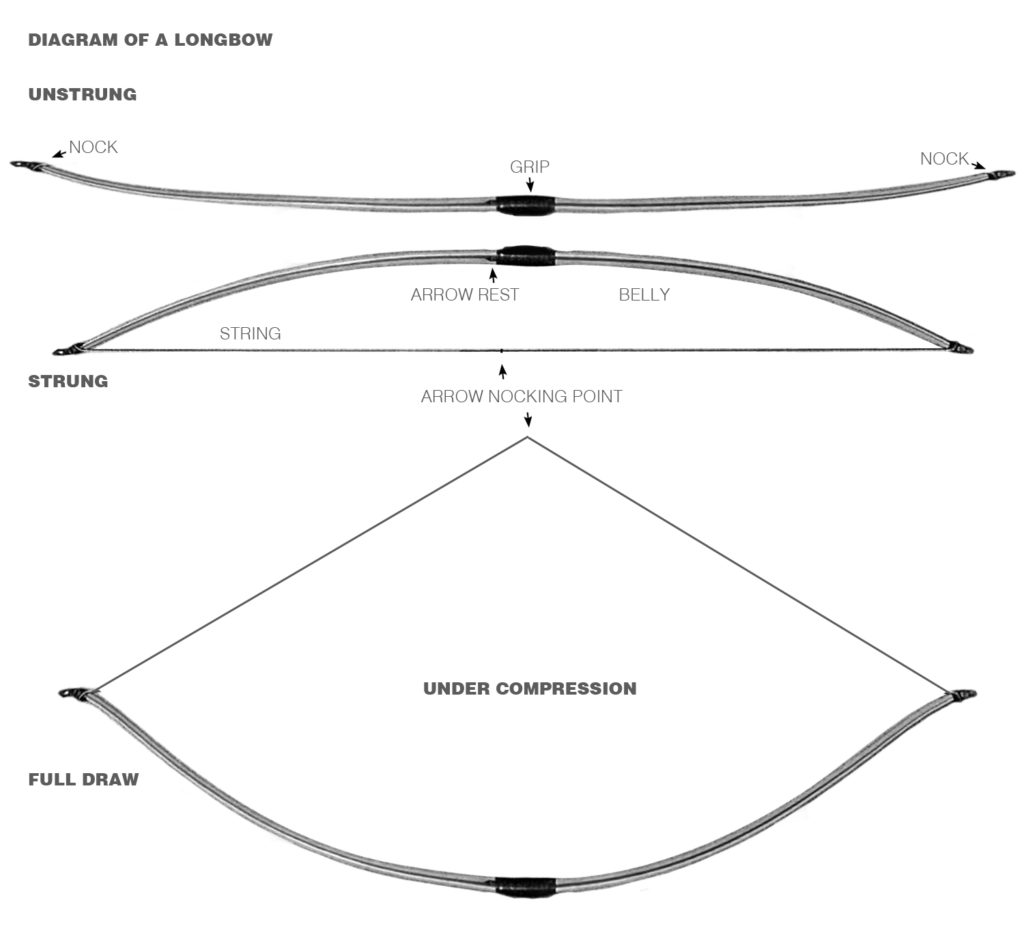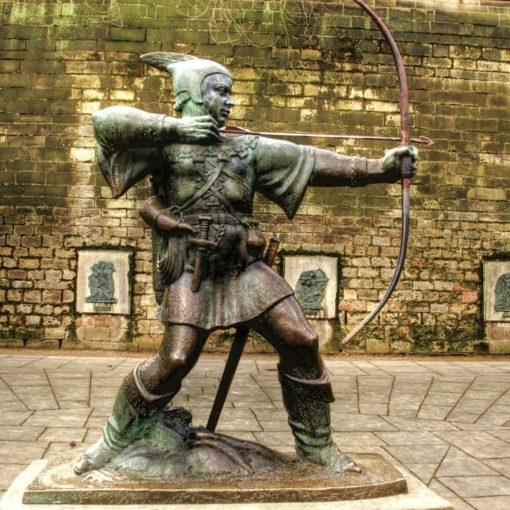
As bows go the longbow is a simple one, compared to many designs from around the world incorporating different materials, lamination, shape-forming etc. such as the famous Turkish composite bows. In essence the design is very simple being a straight stave of wood carved to form. However, despite this simplicity it is very easy to make a poor or mediocre longbow with disappointing performance. The devil really is in the detail as soon as the fundamental basic requirements of the design have been met.
The quality of the woods used and precision of workmanship are the deciding factors between a bow that just works and one that impresses with its performance. Great lengths were gone to in the past to achieve this. Also as the manufacture of longbows became more established over the centuries it appears improvements were made to the consistency of the quality. It appears that no other nation like England maintained such a high quality of battlefield archery with the simple wooden bow as part of its military machine. Where other nations refined the design configuration of weapons and construction techniques with their composite bows, the English retained a basic design that worked well and took it further by making it from higher quality wood and indeed driving up the quality of that wood through provenance and cultivation.
Early wooden bows are found with a variety of designs. Some of these are primitive but others clearly demonstrate a high level of appreciation of the engineering principles of a good efficient bow. Early prehistoric wooden bows in Europe fall into two basic design categories – flatbows and longbows. The former of these as the name suggests has limbs flattened from back to belly. They are usually broad and have a narrowed handle and many of these are very well designed. It is a versatile design which can be adapted to make a bow from almost any wood. The harder and stronger a wood is, the narrower and shorter the limbs can be made resulting in a faster bow. However if all you have is relatively soft wood you can make a flatbow wider and longer. It will be slower but it will work and will feed your family. Flatbows however take alot of quite complicated carving work to make and the longbow design is a lot less and arguably simpler work. It is also more economical of materials. However as previously alluded to, no less skill is required in the fine tillering and creation of a truly good bow.
An essential characteristic of the longbow is its narrow deep design with the handle being the widest part of the bow. It appears alongside the flatbow in prehistory and is of at least equal antiquity. In fact some of the very oldest artefacts which are most likely to be bows are of the longbow design. One of these is the Stellmore bow which is dated at over 8,000 years old.
We need to mention here the differences between hunting bows and warbows (and their respective arrows). These are actually quite different in their designs and operational requirements, but no doubt both have been pressed into service in each others’ roles at various times. Firstly, the hunting bow – what is it required to do? The answer, harvest game efficiently mainly in forests. What is the warbow required for? Answer, combat in its various forms from pitch battles to skirmishing and as such needs to reach long distances and penetrate body armour.
THE HUNTING BOW
The bow and arrow is a very effective hunting tool for a wide variety of game from birds to large mammals. It needs to be able to have enough power to drive an arrow deep enough to reach vital organs and cause sufficient internal haemmorage and physiological shock to bring the quarry down, as well as reaching the quarry reasonably fast to reduce chance of the quarry jumping out of the way of the arrow. It also needs to be accurate enough to hit the correct zone on the quarry to cause a kill rather than a wound (which would then entail a lengthy trailing of the wounded quarry until it succumbs). The range at which hunting is carried out seldom exceeds 60 yards. Most archers would not be able to be accurate enough beyond this range for the aforementioned reason. Due to the power requirements and relatively short ranges over which it is used, the hunting bow does not need to be any more than 50lb to 80lb at a medium length draw to the face (allowing an accurate aim). Draw weight can be even less than this and as little as around 40lb with a good bow. The style of shooting used with the huting bow involves a draw using primarily arm-strength and movement so it can be performed from a variety of body positions as might be involved in shooting from cover and concealment, and not making too greater a body-movement so as to avoid risking alarming quarry.
For a long time, during the early medieval era there was often no real distinction between warbows and hunting bows. In warfare archery was mainly used in skirmishing situations and not particularly committed long-range volleying. Archers would probably often use the same bow for hunting and warfare.
THE WARBOW
What we commonly understand to be the warbow these days really only took form as distinct from bows for other applications at the turn of the 13th century to 14th, in the reign of Edward I. As the massed artillery battlefield tactcs and deployment we associate with battles of the Hundred Years War developed, the longbow for this began to reuire increasing levels of power. For effective use against armoured adversaries at range, the bow was reqired to propel a heavy arrow that would deliver a heavy impact at distance. Draw-weights rose to the level that a bow of 100lb would not be a heavy one. The bow had to be longer to accomodate this amount of draw-weight drawn to a long draw to the ear. Such a draw necessitated the use of the muscles of the back in what we know today as the warbow-technique …shooting ‘in the bow’.




